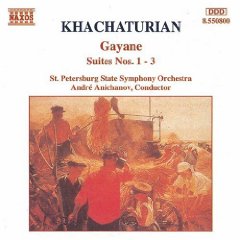Aram Chaczaturian - Gayane Suites Nos. 1 - 3 (1994)
Aram Khachaturian - Gayane Suites Nos. 1-3 (1994)

Gayane Suite No. 1
I. Introduction 00:01:31
II. Gayane and Giko 00:02:51
III. Armen's Solo 00:03:44
IV. Matsak and Armen 00:03:38
V. Gayane's Solo 00:03:35
Gayane Suite No. 2
I. Harvest Holiday 00:02:33
II. Dance of the Girls 00:02:31
III. Dance of the Boys 00:02:18
IV. Choosing the Bride 00:03:04
V. Lullaby 00:05:16
VI. Sabre Dance 00:02:26
Gayane Suite No. 3
I. The Hunt - Andante 00:05:01
II. Dance of the Comrades 00:01:50
III. Matsak's Solo 00:01:42
IV. Gayane's Adagio 00:04:56
V. Solo - Love Duet 00:04:49
VI. Finale 00:04:
St. Petersburg State Symphony Orchestra
Andre Anichanov – conductor
Aram Khachaturian's ballet Gayane, variously spelled "Gayne," "Gayaneh," and "Gayané," had its premiere at the Kirov Ballet on December 9, 1942, in wartime. The ballet's story concerned a young woman named Gayane living on a collective farm of which her father is the chairman. Gayane helps entrap a spy bent on stealing Soviet geological secrets. That clunker of a Communist plot may explain why recordings of the entire ballet have been hard to find in recent decades, even though Gayane spawned one of the last of the great orchestral warhorses, the Sabre Dance. Originally part of a suite of ethnic dances in the ballet's second act, the Sabre Dance is an irresistible piece of fun that's known and loved far beyond the confines of classical music fandom. Its appeal partly derives from its combination of a highly dissonant element, an alternation between major and minor sevenths with full-blown, hell-for-leather, stomp-your-feet forward motion.
The neglect of the rest of Khachaturian's music is a shame, for the ballet has many noteworthy moments of folkloric flavor beyond the Sabre Dance. The story resolves itself in praise for the friendship among the various peoples of the Soviet Union, a development that gave the Georgian-born and Armenian-begotten Khachaturian plenty of room to explore the rhythms and textures of Central Asian folk music. Two of the other dances in the Act II set evokes a group much in the news, the Kurds, and in general Gayane did much to inspire a folkloristic strain in postwar Soviet music even as its composer suffered condemnation at the hands of Stalinist cultural thugs. Gayane, whose music Khachaturian created for Russian ballerina Nina Anisimova, enjoyed several revivals in the years after its composition, and each time Khachaturian tinkered with the score. One indication of the music's riches and its popularity in its own day is that the composer extracted three orchestral suites from the music during and after the ballet's composition. ---James Manheim, Rovi
download: uploaded filecloudio anonfiles yandex 4shared solidfiles mediafire mega nornar
Zmieniony (Środa, 22 Styczeń 2014 17:20)








